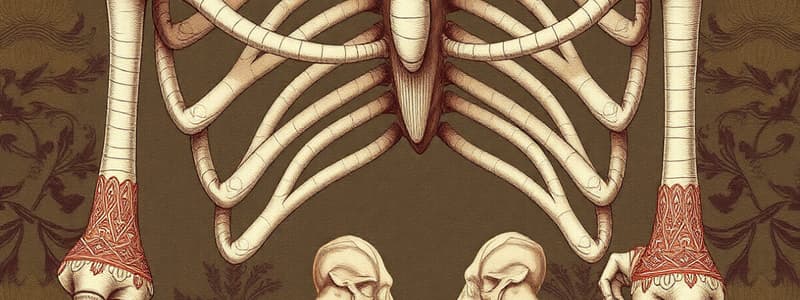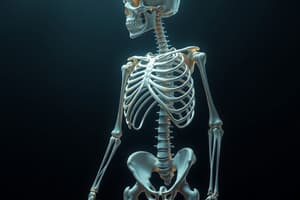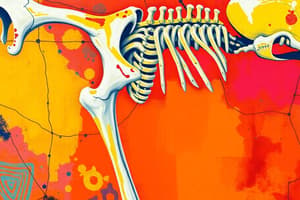Podcast
Questions and Answers
What connects bone to bone in the skeletal system?
What connects bone to bone in the skeletal system?
- Tendons
- Cartilage
- Ligaments (correct)
- Muscles
Which cells are responsible for forming cartilage?
Which cells are responsible for forming cartilage?
- Osteoblasts
- Osteoclasts
- Chondroblasts (correct)
- Osteocytes
What is the primary function of bones supporting the body?
What is the primary function of bones supporting the body?
- Supporting body shape (correct)
- Forming blood cells
- Enabling movement
- Transmitting sound vibrations
What is osteoporosis characterized by?
What is osteoporosis characterized by?
Which type of cartilage is found in the developing fetal skeleton?
Which type of cartilage is found in the developing fetal skeleton?
How do osteoclasts contribute to bone health?
How do osteoclasts contribute to bone health?
What happens to a woman's bone density after menopause?
What happens to a woman's bone density after menopause?
What substance do bones primarily store that is critical for blood function?
What substance do bones primarily store that is critical for blood function?
What is the primary function of tendons in the skeletal system?
What is the primary function of tendons in the skeletal system?
Which type of bone is lighter due to its structure, but also less strong?
Which type of bone is lighter due to its structure, but also less strong?
What type of vertebrae are found in the neck region?
What type of vertebrae are found in the neck region?
What is the main function of intervertebral disks?
What is the main function of intervertebral disks?
What characterizes a herniated disk compared to a ruptured disk?
What characterizes a herniated disk compared to a ruptured disk?
Which of the following describes the function of the ribs?
Which of the following describes the function of the ribs?
How many pairs of ribs are there in the human body?
How many pairs of ribs are there in the human body?
Which bones are involved in the pelvic girdle?
Which bones are involved in the pelvic girdle?
What characteristic differentiates a female pelvis from a male pelvis?
What characteristic differentiates a female pelvis from a male pelvis?
What is one common consequence of spinal injuries?
What is one common consequence of spinal injuries?
What can happen to the softer center of intervertebral disks due to sudden movements or strain?
What can happen to the softer center of intervertebral disks due to sudden movements or strain?
Which of the following is true about the clavicle?
Which of the following is true about the clavicle?
Which bone is part of the arm?
Which bone is part of the arm?
What type of joint is characterized as immovable?
What type of joint is characterized as immovable?
Which process describes the repair of a broken bone?
Which process describes the repair of a broken bone?
Which type of arthritis is an autoimmune disease?
Which type of arthritis is an autoimmune disease?
Which joint type allows for a wide range of movement?
Which joint type allows for a wide range of movement?
What happens to cartilage in osteoarthritis?
What happens to cartilage in osteoarthritis?
What may occur during a dislocation?
What may occur during a dislocation?
What is a common symptom of torn cartilage?
What is a common symptom of torn cartilage?
Which type of joint is an example of a hinge joint?
Which type of joint is an example of a hinge joint?
What is the first step in the healing process of a broken bone?
What is the first step in the healing process of a broken bone?
What hormone is primarily responsible for lengthening bones during adolescence?
What hormone is primarily responsible for lengthening bones during adolescence?
Which of the following hormones adds calcium to the bone?
Which of the following hormones adds calcium to the bone?
What is the main reason men are generally taller than women?
What is the main reason men are generally taller than women?
What characterizes the primary difference in growth patterns between girls and boys during puberty?
What characterizes the primary difference in growth patterns between girls and boys during puberty?
At what stage of development do chondroblasts form the cartilage model in long bone development?
At what stage of development do chondroblasts form the cartilage model in long bone development?
What happens to the cartilage growth plate during puberty?
What happens to the cartilage growth plate during puberty?
How does low blood calcium affect parathyroid hormone levels?
How does low blood calcium affect parathyroid hormone levels?
What role do sinuses serve in the skull?
What role do sinuses serve in the skull?
Which of the following cells is responsible for forming bone?
Which of the following cells is responsible for forming bone?
What is the function of parathyroid hormone in relation to calcium levels?
What is the function of parathyroid hormone in relation to calcium levels?
What is the primary function of epithelial tissue?
What is the primary function of epithelial tissue?
Which of the following correctly describes connective tissue?
Which of the following correctly describes connective tissue?
What characterizes simple epithelial tissue?
What characterizes simple epithelial tissue?
What type of connective tissue is associated with flexibility and support?
What type of connective tissue is associated with flexibility and support?
Which tissue type is responsible for generating electrical signals?
Which tissue type is responsible for generating electrical signals?
What is the primary characteristic of stratified epithelial tissue?
What is the primary characteristic of stratified epithelial tissue?
What distinguishes dense irregular connective tissue from loose connective tissue?
What distinguishes dense irregular connective tissue from loose connective tissue?
What types of glands secrete hormones into the blood?
What types of glands secrete hormones into the blood?
Which of the following is NOT a type of connective tissue?
Which of the following is NOT a type of connective tissue?
Which fiber in connective tissue provides stretch and flexibility?
Which fiber in connective tissue provides stretch and flexibility?
What is one of the primary functions of adipose tissue?
What is one of the primary functions of adipose tissue?
Which of the following functions is NOT performed by the skin?
Which of the following functions is NOT performed by the skin?
How does dark skin provide an advantage in sunny regions?
How does dark skin provide an advantage in sunny regions?
What role do melanocytes play in the skin?
What role do melanocytes play in the skin?
What is a primary function of the epidermis?
What is a primary function of the epidermis?
Which of the following statements best describes the relationships between tissues, organs, and organ systems?
Which of the following statements best describes the relationships between tissues, organs, and organ systems?
What is the role of keratin in the skin?
What is the role of keratin in the skin?
Which skin color presents the advantage in vitamin D production in less sunny regions?
Which skin color presents the advantage in vitamin D production in less sunny regions?
What is a characteristic function of the integumentary system regarding infection?
What is a characteristic function of the integumentary system regarding infection?
How does the body regulate temperature through the skin?
How does the body regulate temperature through the skin?
What type of cartilage is characterized by having thick collagen bundles and can withstand pressure?
What type of cartilage is characterized by having thick collagen bundles and can withstand pressure?
Which of the following components is NOT found in blood?
Which of the following components is NOT found in blood?
What kind of connective tissue surrounds organs that experience little stretching, such as the kidneys?
What kind of connective tissue surrounds organs that experience little stretching, such as the kidneys?
What makes cartilage heal more slowly than other types of connective tissue?
What makes cartilage heal more slowly than other types of connective tissue?
Which component of bone is primarily responsible for nutrient and waste exchange?
Which component of bone is primarily responsible for nutrient and waste exchange?
Which type of connective tissue is primarily associated with fat storage?
Which type of connective tissue is primarily associated with fat storage?
What is the primary structural protein found in the cartilage matrix?
What is the primary structural protein found in the cartilage matrix?
Where is hyaline cartilage typically found?
Where is hyaline cartilage typically found?
What characteristic distinguishes elastic cartilage from other types?
What characteristic distinguishes elastic cartilage from other types?
Which specialized connective tissue is responsible for intercellular transport and immune response?
Which specialized connective tissue is responsible for intercellular transport and immune response?
Flashcards are hidden until you start studying
Study Notes
Skeletal System Overview
- Composed of connective tissues: bones, cartilage, ligaments, and tendons.
- Bones comprise mostly calcium and phosphate crystals, collagen, and elastin fibers.
- Cartilage contains collagen and elastin fibers; it supports and cushions joints.
- Ligaments connect bone to bone, while tendons connect muscle to bone, both being dense, regular connective tissues.
Bone Functions
- Muscles attach to bones enabling movement.
- Supports body structure and shape.
- Protects vital organs (e.g., ribcage, skull, vertebrae).
- Forms blood cells in specific bones (e.g., femur, humerus).
- Stores calcium and regulates blood calcium homeostasis.
- Smallest bones in the middle ear aid in sound transmission.
Bone Structure and Cells
- Hyaline cartilage covers bone surfaces; spongy bone is lighter but provides structural support.
- Chondroblasts form cartilage, while osteoblasts form solid bone and become osteocytes for maintenance.
- Osteoclasts break down bone for remodeling and calcium release.
Bone Remodeling
- Remodeling involves changes in bone shape, size, and strength through osteoclast and osteoblast activity.
- Osteoporosis characterized by low bone density can result from an imbalance between osteoclast and osteoblast activities, particularly after menopause.
Long Bone Development
- Initially consists of hyaline cartilage which is gradually replaced by bone during fetal development.
- Growth hormone and sex hormones (estrogen/testosterone) stimulate bone growth and ossification during puberty, which leads to growth plate fusion and cessation of bone lengthening.
Hormonal Regulation of Blood Calcium
- Parathyroid hormone increases blood calcium by stimulating osteoclasts.
- Calcitonin decreases blood calcium levels by promoting osteoblasts.
- Calcium is essential for muscle contraction and nervous function.
Axial Skeleton
- Comprised of the skull and vertebral column.
- 33 vertebrae support the spinal cord and can be categorized into cervical, thoracic, lumbar, sacral, and coccyx regions.
- Intervertebral discs provide cushioning and flexibility; herniated discs can cause nerve compression.
Appendicular Skeleton
- Includes the pectoral girdle (shoulders) and pelvic girdle (hips), with differences in male and female structures.
- Limbs consist of long bones with specific names (e.g., humerus, femur).
Joints Classification
- Fibrous joints: immovable (e.g., skull sutures).
- Cartilaginous joints: slightly movable (e.g., between vertebrae).
- Synovial joints: freely movable; include hinge and ball-and-socket types, with lubricating synovial fluid.
Common Skeletal System Problems
- Dislocations occur when bones are forced out of joints, often accompanied by sprains.
- Broken bones undergo a healing process: hematoma formation, callus creation by chondroblasts, osteoclast activity for cleaning, and osteoblasts building new bone.
- Torn cartilage heals slowly due to a low blood supply; surgical intervention may be necessary for repairs.
- Arthritis involves joint inflammation, with osteoarthritis resulting from cartilage wear and rheumatoid arthritis being an autoimmune condition.
Introduction to Tissues and Skin
- Four primary types of tissues: epithelial, connective, muscle, and nervous.
- Skin functions as an organ system composed of multiple tissues.
Types of Tissues
- Epithelial Tissue: Covers body surfaces; includes epidermis, lining of blood vessels, and digestive tract.
- Connective Tissue: Supports and connects body parts; includes tendons, ligaments, cartilage, and adipose tissue.
- Muscle Tissue: Responsible for movement; categorized into skeletal, cardiac, and smooth muscle.
- Nervous Tissue: Generates electrical signals for information transmission.
Epithelial Tissues
- Comprises sheets of interconnected cells.
- Simple Epithelium: One layer, allows for diffusion and secretion.
- Stratified Epithelium: Multiple layers, provides protection against abrasion and infection.
Glands in Epithelial Tissue
- Glandular Epithelia: Produces and secretes chemicals.
- Exocrine Glands: Release secretions into hollow organs (e.g., saliva, digestive enzymes).
- Endocrine Glands: Secrete hormones directly into the bloodstream.
Connective Tissue Characteristics
- Composed of loosely packed cells within a protein matrix.
- Matrix includes collagen, elastin, and reticular fibers for structure and support.
Types of Fibrous Connective Tissue
- Loose Connective Tissue: Surrounds internal organs and blood vessels; flexible but weak.
- Dense Irregular Connective Tissue: Found in the dermis, strong but less flexible.
- Elastic Connective Tissue: High elastin content; found in organs that require flexibility (e.g., bladder).
- Dense Regular Connective Tissue: Contains parallel collagen fibers; forms tendons and ligaments.
Specialized Connective Tissues
- Cartilage: Provides support; heals slowly due to lack of blood vessels.
- Hyaline cartilage (smooth, reduces friction in joints).
- Elastic cartilage (flexible, found in ears).
- Fibrocartilage (dense, withstands pressure in vertebral disks).
- Bone: Comprised of collagen, elastin, and a hardened matrix; enables quick healing due to blood supply.
- Blood: Contains plasma and cells; involved in transport, immune functions, and clotting.
- Adipose Tissue: Stores fat for insulation and energy.
Organ Systems
- Tissues collaborate to form organs, which in turn function in coordinated organ systems including:
- Integumentary, nervous, skeletal, muscular, endocrine, circulatory, digestive, urinary, immune, reproductive, and respiratory systems.
Skin as Part of the Integumentary System
- Functions of Skin:
- Prevents dehydration through keratin.
- Protects underlying tissues from injury.
- Defends against infections via pH barrier and immune cells.
- Regulates body temperature through sweat and blood flow.
- Provides sensory perceptions (touch, temperature, pain).
- Synthesizes vitamin D when exposed to UV light.
- Protects from UV radiation with melanin.
Skin Color Adaptations
- Dark Skin: Provides protection from skin cancer in sunny regions but may hinder vitamin D production in less sunny areas.
- Light Skin: Increases vulnerability to skin cancer in sunny regions but enhances vitamin D production in areas with less sunlight.
The Epidermis
- Composed of dead, flattened keratinocytes; serves as a nearly waterproof barrier.
- Living cells migrate towards the surface, eventually dying due to distance from blood vessels.
- Melanocytes within the epidermis produce melanin, shielding cells from UV-induced mutations.
Studying That Suits You
Use AI to generate personalized quizzes and flashcards to suit your learning preferences.




